Historical accuracy of Centurion

Historical accuracy of Centurion

Characters
Quintus Dias (Michael Fassbender)
A fictional protagonist created for the film. His experiences represent the imagined ordeal of a Roman soldier behind enemy lines in Caledonia.
Titus Flavius Virilus (Dominic West)
While likely named after historical figures, the specific General Virilus commanding the Ninth Legion in this campaign and context is fictionalized for the film's narrative.
Etain (Olga Kurylenko)
A fictional character embodying Pictish resistance and desire for revenge against Rome. While female warriors existed in Celtic societies, Etain's specific backstory and role are fictional.
Bothos (David Morrissey)
Fictional soldier representing the experiences of rank-and-file legionaries.
Brick (Ubriculius) (Liam Cunningham)
Fictional soldier, representing the older, experienced legionary nearing the end of his service.
Macros (Noel Clarke)
Fictional soldier representing the diverse origins of men within the Roman army.
More characters
Thax (JJ Feild)
Fictional soldier representing morally ambiguous or negative aspects within the legion.
Gorlacon (Ulrich Thomsen)
A fictional leader representing the organized Pictish resistance against Roman encroachment.
Gnaeus Julius Agricola (Paul Freeman)
Agricola was a real Roman governor, but he served much earlier (recalled in 85 AD) and was deceased by the film's setting (117 AD). His inclusion is a significant anachronism.
Arianne (Imogen Poots)
A fictional character providing refuge and representing perhaps those caught between Roman and Pictish societies or ostracized within their own.
Story
Roman difficulties conquering northern Britain
Romans did struggle to fully subdue the tribes of Caledonia (modern Scotland) and eventually settled for consolidation behind Hadrian's Wall.
Existence of conflict between Romans and Picts
There were ongoing hostilities and campaigns between Roman forces in Britain and the northern tribes, collectively referred to later as Picts.
Ninth Legion marching north into Caledonia (c. 117 AD)
This is the core legend the film adapts. While the Ninth Legion was stationed in Britain, firm evidence of a campaign this far north leading to its destruction in Scotland around 117 AD is lacking. Historical consensus suggests the legion was likely transferred elsewhere later.
Ninth Legion massacred/destroyed in Caledonia
The film depicts the legion being wiped out based on the disappearance legend. Historical evidence points towards the legion being redeployed (perhaps to Nijmegen in Germania) or possibly suffering losses elsewhere, but not total annihilation in Scotland.
Pictish guerrilla warfare tactics (ambush)
The film accurately portrays the likelihood of northern tribes using terrain knowledge and ambush tactics against marching Roman columns, a common challenge for Roman forces on hostile frontiers.
Small group of Roman survivors escaping south
This is the fictional survival narrative based on the fictional premise of the legion's destruction in Caledonia.
Romans betraying survivors to hide legion's loss
The film's ending, where Roman command (represented by the anachronistic Agricola) attempts to erase the survivors to cover up the disaster, is a purely fictional plot point.
Harsh realities of Roman legionary life on frontier
Portrays the difficult conditions, constant danger, and brutal nature of military service on the fringes of the Roman Empire.
Picts speaking Gaelic
The film uses Scots Gaelic for the Picts. While the actual Pictish language is poorly understood, it's generally thought to be related to Brittonic (like Welsh), not Gaelic. The choice was made for audience familiarity.
Setting
Northern Roman Britain / Caledonia (c. 117 AD)
Visually captures the rugged, forested, and often harsh landscape of northern Britain/Scotland, providing a believable backdrop for the frontier conflict (filmed mostly in Scotland).
Roman Forts (e.g., Pinnata Castra / Inchtuthil)
Depicts typical Roman frontier forts constructed of timber, reflecting archaeological understanding of such outposts. Inchtuthil was a real legionary fortress, though abandoned earlier than the film's date.
Pictish Settlements/Lifestyle
Shows Picts as fierce tribal warriors living in tune with the harsh landscape. Specific details of settlements or daily life are limited and likely generalized.
Roman Legionary Equipment (Armor, Weapons)
Shows segmented armor (lorica segmentata), mail (lorica hamata), helmets, shields (scuta), swords (gladii). While aiming for authenticity, some inaccuracies noted by reenactors (e.g., lack of pilum, wrist guards, details on mail).
Pictish Appearance and Weaponry
Portrays Picts with woad-like markings, somewhat primitive attire, and sometimes non-metallic weapons (bone). Historically, they used iron weapons (spears, swords) and likely wore practical clothing like tunics. Woad use is debated/unlikely this late.
Climate and Environment
Emphasizes the cold, wet, and difficult environment, accurately reflecting the challenging conditions faced by Romans campaigning in northern Britain.
Atmosphere of Frontier Warfare
Successfully conveys the brutality, desperation, and uncertainty of warfare on the edge of the Roman Empire against resistant tribes.
Hadrian's Wall
The film is set around the time construction began (c. 119-122 AD), making its presence or imminent construction contextually relevant, though its completed form might be shown prematurely.
